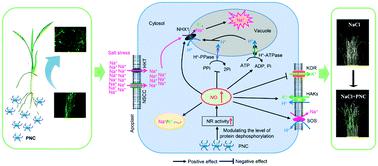当前位置:
X-MOL 学术
›
Environ. Sci.: Nano
›
论文详情
Our official English website, www.x-mol.net, welcomes your
feedback! (Note: you will need to create a separate account there.)
Molecular basis of cerium oxide nanoparticle enhancement of rice salt tolerance and yield
Environmental Science: Nano ( IF 5.8 ) Pub Date : 2021-09-18 , DOI: 10.1039/d1en00390a Heng Zhou 1 , Honghong Wu 2, 3 , Feng Zhang 1 , Ye Su 1 , Wenxue Guan 1 , Yanjie Xie 1 , Juan Pablo Giraldo 3 , Wenbiao Shen 1
Environmental Science: Nano ( IF 5.8 ) Pub Date : 2021-09-18 , DOI: 10.1039/d1en00390a Heng Zhou 1 , Honghong Wu 2, 3 , Feng Zhang 1 , Ye Su 1 , Wenxue Guan 1 , Yanjie Xie 1 , Juan Pablo Giraldo 3 , Wenbiao Shen 1
Affiliation

|
Herein, we demonstrate and elucidate how biocompatible poly(acrylic acid) coated cerium oxide nanoparticles (PNC) improve rice tolerance and crop yield under salinity stress. Rice seedlings hydroponically supplied with PNC (1 μM, 98 μg L−1) have a higher shoot length (33.3%), fresh weight (56.9%), and chlorophyll content (123.9%) compared to controls after being exposed to 100 mM NaCl for 8 days. Similarly, greenhouse experiments reveal that during the reproductive stage, PNC (10 μM, 0.98 mg L−1)-exposed rice plants upon exposure to NaCl stress (7.2 dS m−1; two months) exhibited increased chlorophyll content (23.9%), dry weight (50.5%), and grain weight (47.1%) compared with non-nanoparticle stressed controls. Importantly, the cerium (Ce) content in harvested grains of PNC-supplemented rice plants (18.3 ± 3.1 μg per kg dry weight) is similar to those of samples without nanoparticles, under both control and stress conditions. Molecular evidence showed that PNC enhance nitric oxide (NO) production (30.5%) by inducing the transcription of nia2 (a gene encoding nitrate reductase) and controlling the dephosphorylation of its protein, thus resulting in NO production and plant tolerance against salinity. The crucial role of NIA2-dependent NO synthesis was evaluated by manipulation of endogenous NO levels and in nia2 mutants. The nanoparticle-mediated NO control of salinity tolerance could be explained by reducing reactive oxygen species accumulation (39.5%) and maintaining ion homeostasis. Overall, NO signaling is involved in PNC control of salt tolerance. Our results also indicated that PNC are promising nanobiotechnology tools for improving crop performance and yield in salt stressed fields without increasing the Ce content in cereal grains.
中文翻译:

氧化铈纳米颗粒增强水稻耐盐性和产量的分子基础
在此,我们展示并阐明了生物相容性聚(丙烯酸)包覆的氧化铈纳米粒子 (PNC) 如何在盐分胁迫下提高水稻耐受性和作物产量。在暴露于 100 mM NaCl 后,与对照相比,使用 PNC (1 μM, 98 μg L -1 )水培供应的水稻幼苗具有更高的芽长 (33.3%)、鲜重 (56.9%) 和叶绿素含量 (123.9%) 8 天。类似地,温室实验表明,在生殖阶段,PNC(10 μM,0.98 mg L -1)暴露于 NaCl 胁迫(7.2 dS m -1; 两个月)与非纳米颗粒应激对照相比,叶绿素含量 (23.9%)、干重 (50.5%) 和粒重 (47.1%) 增加。重要的是,在控制和胁迫条件下,添加了 PNC 的水稻收获谷物中的铈 (Ce) 含量(18.3 ± 3.1 μg/kg 干重)与不含纳米颗粒的样品相似。分子证据表明,PNC 通过诱导nia2(一种编码硝酸还原酶的基因)的转录并控制其蛋白质的去磷酸化来增加一氧化氮 (NO) 的产生 (30.5%) ,从而导致 NO 产生和植物对盐分的耐受性。通过操纵内源性 NO 水平和nia2 来评估 NIA2 依赖性 NO 合成的关键作用突变体。纳米颗粒介导的 NO 对耐盐性的控制可以通过减少活性氧的积累 (39.5%) 和维持离子稳态来解释。总体而言,NO 信号参与了 PNC 对耐盐性的控制。我们的研究结果还表明,PNC 是一种很有前途的纳米生物技术工具,可以在不增加谷物中 Ce 含量的情况下提高盐胁迫田的作物性能和产量。
更新日期:2021-10-04
中文翻译:

氧化铈纳米颗粒增强水稻耐盐性和产量的分子基础
在此,我们展示并阐明了生物相容性聚(丙烯酸)包覆的氧化铈纳米粒子 (PNC) 如何在盐分胁迫下提高水稻耐受性和作物产量。在暴露于 100 mM NaCl 后,与对照相比,使用 PNC (1 μM, 98 μg L -1 )水培供应的水稻幼苗具有更高的芽长 (33.3%)、鲜重 (56.9%) 和叶绿素含量 (123.9%) 8 天。类似地,温室实验表明,在生殖阶段,PNC(10 μM,0.98 mg L -1)暴露于 NaCl 胁迫(7.2 dS m -1; 两个月)与非纳米颗粒应激对照相比,叶绿素含量 (23.9%)、干重 (50.5%) 和粒重 (47.1%) 增加。重要的是,在控制和胁迫条件下,添加了 PNC 的水稻收获谷物中的铈 (Ce) 含量(18.3 ± 3.1 μg/kg 干重)与不含纳米颗粒的样品相似。分子证据表明,PNC 通过诱导nia2(一种编码硝酸还原酶的基因)的转录并控制其蛋白质的去磷酸化来增加一氧化氮 (NO) 的产生 (30.5%) ,从而导致 NO 产生和植物对盐分的耐受性。通过操纵内源性 NO 水平和nia2 来评估 NIA2 依赖性 NO 合成的关键作用突变体。纳米颗粒介导的 NO 对耐盐性的控制可以通过减少活性氧的积累 (39.5%) 和维持离子稳态来解释。总体而言,NO 信号参与了 PNC 对耐盐性的控制。我们的研究结果还表明,PNC 是一种很有前途的纳米生物技术工具,可以在不增加谷物中 Ce 含量的情况下提高盐胁迫田的作物性能和产量。











































 京公网安备 11010802027423号
京公网安备 11010802027423号